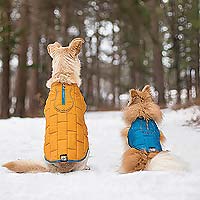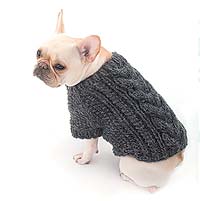Moab has been pretty cold this winter, and it’s doggone cold across most of the U.S. and elsewhere around the globe. Winter weather can be challenging, and for pet parents one of the challenges is knowing how cold is too cold to have canine companions outside.
Here are a few important factors that determine how well your dog handles the cold:
• Coat type — Double-coated dogs, especially northern breeds like Siberian Huskies and Samoyeds, tend to do much better in frigid temps than other breeds. For dogs with thin coats like the Greyhound, the opposite is true.
• Age — Puppies, senior and geriatric dogs can’t regulate their body temperature as efficiently as healthy adult dogs, so they get much colder, much faster.
• Size — Small dogs have a greater surface area to volume ratio, meaning they have more skin (as compared to their “innards”) through which heat escapes. All that to say, the average little dog gets colder faster than the average large dog.
Health status — Dogs with mobility issues or a chronic health condition will be at much greater risk for hypothermia in cold weather than healthy dogs.
• Weight — Lean dogs get colder much faster than dogs with more insulating body fat. The same is true for humans.
• Coat color — Dogs with darker coats absorb heat from the sunlight, so on a clear, sunny winter day, they’ll be significantly warmer than their light-coated counterparts.
These are general guidelines, but it’s important to remember that dogs are individuals, and while you might think yours loves the outdoors in cold weather, it’s important to stay alert for signs that it’s time to head indoors. These include:
Holding up a paw – Shivering – Anxiety - Searching for warmth – Whining – Weakness - Lack of mental alertness - Slowing down
A good general guideline on outdoor temperatures:
Below 45°F, dogs who don’t love the cold start to feel uncomfortable.
Below 32°F, small breeds, thin-coated dogs, and old, young, and sick dogs should be very carefully monitored for signs of discomfort.
Below 20°F, hypothermia and frostbite are a risk for all dogs.
Additional considerations:
Are the skies sunny or cloudy? Overcast days feel colder than sunny days, and in addition, there’s no opportunity for dark-coated dogs to absorb sunshine to help retain body heat.
Is it raining or snowing? Any sort of dampness that saturates your dog’s coat can quickly drop her body temperature even when it’s not terribly cold out.
Is the wind blowing? Windy days can make the temperature feel much colder than the number on the thermostat. In addition, breezy conditions inhibit the ability of your dog’s coat to insulate and protect him from the cold.
What are your plans for your dog while she’s outdoors? Your dog’s activity level makes a big difference in how quickly she gets cold. If she’s running or playing vigorously, she’s generating a good deal of body heat that will protect her from getting cold quickly.
Dogs Who May Need to Bundle Up
One sign that your dog is feeling uncomfortably chilly is a hesitance to go outside to relieve herself. If she’s trying to stay in physical contact with you, it’s another sign she may be having trouble maintaining body heat. And obviously, shivering is a big red flag.
If your dog is visibly chilled, is a small or toy breed, has a short or thin coat, is older, doesn’t get around well or has a chronic health condition, a sweater or jacket may the best thing for her, even indoors.
Dogs less likely to need sweaters are large breeds with dense coats. In fact, most dogs bred for cold climates can actually overheat in a sweater or jacket. Overweight dogs often don’t need extra insulation, but breeds like the Chihuahua, many of the pinscher and terrier breeds, and the Greyhound, are examples of dogs who often need winter wardrobes.
How to Fit Your Dog for a Sweater
When picking a sweater for your dog, I recommend a fabric that can be easily washed and dried, and one that won’t itch or irritate your pet’s skin. Measure the circumference of your dog’s neck and chest and the length of his body from neck to waist, plus take his weight, so that you can select clothing that fits.
A dog sweater should be snug, but not tight. The length should end at the rib cage, leaving the back end free. The neck and leg holes should be big enough that your dog can move freely, but not so big that he can pull his head or a leg out.
I recommend plain sweaters without zippers, hooks, buttons or other embellishments that can be both annoying to your dog and a choking hazard. The sweater should be easy to put on and take off without a struggle.
It may take a few tries before you hit on the right size and fit, so either take your dog with you so you can try things on him, or shop at retailers with liberal return policies. Knowing your dog’s circumference measurements for their neck and deepest part of the chest will often help you pick the right size the first time.
If you put a sweater on your dog, especially indoors, check regularly to make sure he’s still comfortable. I recommend taking sweaters off every few hours to prevent overheating or an itchy rash.
Keep in mind that not every dog who needs a coat will wear one. It’s just too unnatural for some pups. So, don’t force your dog to wear any item of clothing if it means he can’t act or move naturally.
One last thing: dogs rarely, if ever, need pants. And heavy boots are also unnecessary in most instances, especially since dogs feel the ground with their paws and anything that interferes with their ability to sense their environment is uncomfortable. Use lightweight rubber booties or paw protecting salves to help with harsh winter weather. If you live in a heavily contaminated environment, walk on ice/snow or slickrock regularly training your dog to wear boots may be best. Stay warm out there Moab, the warm weather is just around the seasonal corner.
Dog-Friendly Walks/Hikes
in the Moab Area |
Corona Arch - Easy/Moderate. 1.3 Miles one way. Trailhead is 25 minute drive from Moab.
North on US-191 to Potash Road (Utah 279).
Mill Creek Pathway - Easy. 1.1 Miles. Little to no driving. Starts at the intersection of 100 South and 100 West,
a block off of Main Street.
Portal Overlook - Hard. 2.0 Miles one way. Trailhead is 20 minute drive from Moab.
North on US-191 to Potash Road (Utah 279).
Grandstaff Canyon - Moderate. 2.0 Miles one way. Trailhead is 10-minute drive from Moab.
North on US-191 to the River Road (Utah 128) |
|